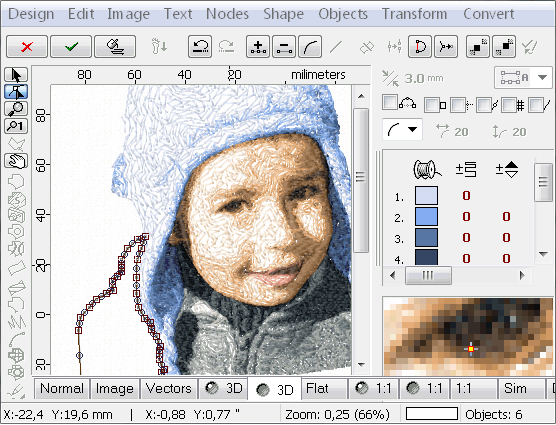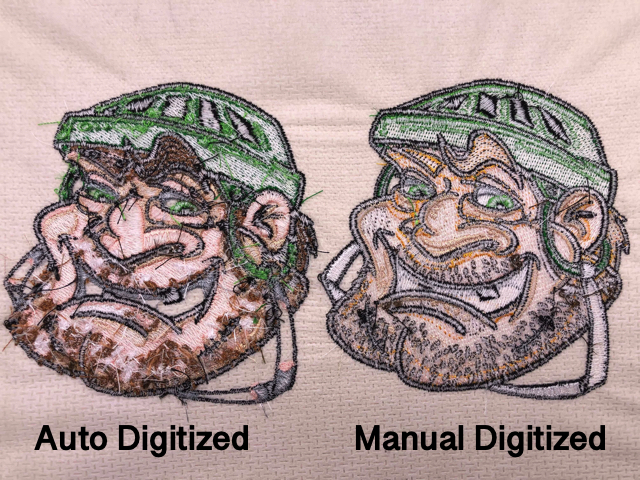Grasping the Embroidery Digitizing Refine: Your Ultimate Guide
Needlework digitizing is a careful craft that requires precision and knowledge to translate detailed styles into electronic formats for maker embroidery. As craftsmens start this journey to understand the embroidery digitizing procedure, an extensive understanding of the essentials sets the structure for quality. Nonetheless, beyond the rudimentary expertise lies a world of sophisticated software program, specialized tools, and nuanced techniques waiting to be discovered. By delving right into the subtleties of digitizing, one can open a world of creative opportunities and elevate their embroidery jobs to brand-new elevations.

Comprehending Needlework Digitizing Essentials
Embroidery digitizing essentials create the foundation upon which complex layouts are translated right into machine-readable styles for exact sewing. This preliminary action in the embroidery digitizing process is essential for making certain that the last stitched item is a devoted representation of the original design. Understanding needlework digitizing essentials entails realizing crucial ideas such as stitch types, stitch direction, density, underlay, and pull compensation.
Sew kinds play an essential duty in establishing the aesthetic and textural result of the embroidered design. By picking the proper stitch kind, whether it be satin, fill, or running stitch, digitizers can accomplish the preferred impact and improve the general high quality of the needlework. Furthermore, stitch direction affects the circulation and measurement of the style, while thickness identifies the spacing and protection of the stitches.
Additionally, padding sewing supplies stability to the design by securing the material and preventing distortion throughout the needlework process. Pull compensation is an additional crucial factor to consider to counteract the natural tendency of material to agreement when sewn. Grasping these embroidery digitizing fundamentals is fundamental for producing professional-quality embroidered items.
Choosing the Right Digitizing Software Application
Picking the appropriate digitizing software application is a critical decision that significantly affects the performance and top quality of the embroidery digitizing process. Digitizing for Embroidery. When selecting the appropriate digitizing software, it is important to consider elements such as the intricacy of layouts you plan to produce, the user-friendliness of the software program, the level of customer assistance offered, and the compatibility with your embroidery equipment
There are various digitizing software choices readily available in the market, ranging from fundamental programs for novices to innovative software program for professional digitizers. Some prominent options consist of Wilcom EmbroideryStudio, Hatch Needlework Software Program, and PulseID. These software offer a large range of tools and functions to aid you create detailed designs effortlessly.
Before making a decision, it is advisable to check out the different software program options with cost-free tests or demos to determine which one finest matches your needs. Additionally, checking out evaluations and check my site looking for referrals from seasoned digitizers can provide important insights into the staminas and weak points of each software (Digitizing for Embroidery). By very carefully evaluating your demands and contrasting the features of different digitizing software, you can make an informed option that boosts your embroidery digitizing workflow
Digitizing Tools and Methods

Optimizing Style Setup for Needlework
Understanding the complexities of layout settings is essential in attaining ideal lead to the needlework digitizing procedure, structure upon the structure laid by understanding digitizing tools and great site techniques. When maximizing layout settings for needlework, it is vital to think about variables such as stitch type, density, padding, pull settlement, and enrollment. Sew kind choice affects the overall appearance and feel of the style, with choices like satin, fill, and running stitches using various appearances and impacts. Density describes the spacing and thickness of stitches, affecting the style's coverage and durability. Correct rug stitching gives security and prevents textile distortion, particularly for complicated layouts or on elastic materials. Draw compensation readjusts for material stretch during sewing, making sure accurate layout replication. Enrollment settings straighten different elements Get More Info of the style accurately, keeping general layout stability. By fine-tuning these layout settings, embroiderers can boost the high quality and precision of their embroidered creations.

Troubleshooting Common Digitizing Issues
When experiencing usual digitizing issues during the needlework process, it is necessary to understand the origin and execute efficient solutions immediately. One usual problem is stitch thickness issues, where stitches may be also thick, causing the material to tighten, or too sporadic, bring about gaps in the style. Readjusting the stitch density settings in the digitizing software program can help fix this concern.
Another regular challenge is thread breaks during the needlework process. This can happen as a result of different factors such as incorrect tension setups, boring needles, or making use of low-quality string. Ensuring appropriate upkeep of the embroidery maker, consisting of normal needle changes and tension modifications, can decrease the occurrence of thread breaks.
In addition, design registration mistakes can cause misaligned elements within the embroidery layout. Checking the style placement in the digitizing software and making required changes prior to sewing can aid in avoiding this issue. By dealing with these typical digitizing problems quickly and successfully, you can make certain a smoother needlework procedure and high-grade finished products.
Conclusion
In conclusion, mastering the embroidery digitizing process calls for a strong understanding of the basics, the appropriate selection of software program, and knowledge of devices and strategies. Maximizing layout setups and fixing typical digitizing issues are crucial steps in guaranteeing top quality needlework outcomes. By complying with these steps faithfully, one can attain precision and performance in the digitizing procedure.
Comments on “Specialist Digitizing for Embroidery: High-Quality Layouts”